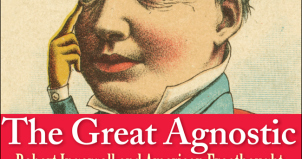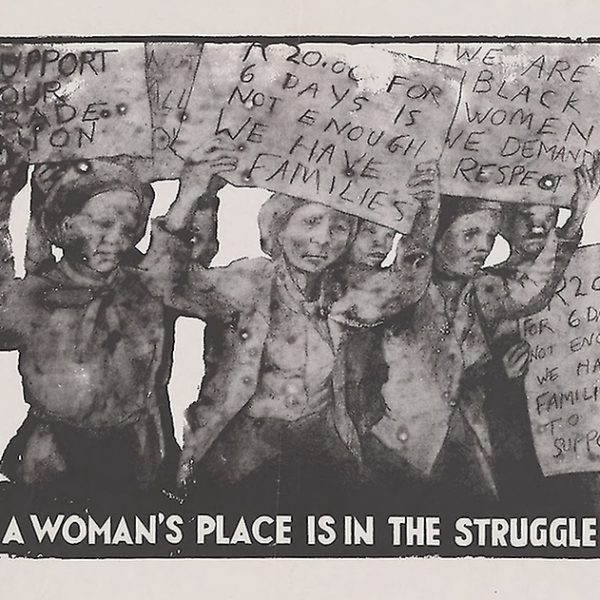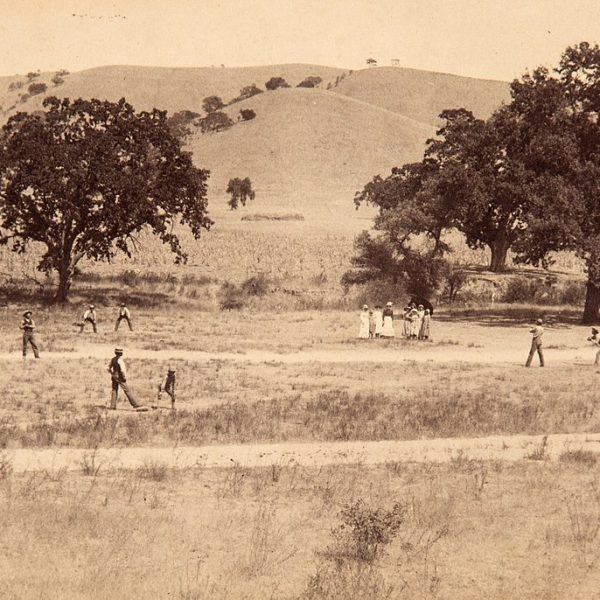The Great Agnostic and First American Male Feminist
Susan Jacoby, author of the new biography, The Great Agnostic: Robert Ingersoll and American Freethought, here reflects on the significance of Ingersoll as a religious and philosophical thinker, considering women’s and human rights in nineteenth-century America and arguing that he was a man well ahead his times—more like twentieth-century feminists than his own contemporaries on the issue of women’s rights.
The Great Agnostic and First American Male Feminist
Susan Jacoby—
Robert Green Ingersoll, known as “The Great Agnostic” when he was America’s most famous orator in the late nineteenth century, was also far ahead of his time in his attitude about equal rights for women. Although he was a prominent Republican during the Gilded Age, he would never have found a place in today’s Republican Party not only because of his advocacy of absolute separation of church and state but because of his insistence that women were entitled to all of the legal benefits and education granted men.
In “Eight Hours Must Come,” an essay published in 1890, Ingersoll not only broke with the robber barons by supporting an eight-hour work day but took the even more extraordinary—at the time, almost unthinkable—position of supporting equal pay for women.
 Economic justice, he said, must apply to women as well as to men and working men should remember that “all who labor are their brothers, and that all women who labor are their sisters.” The worst-paid, worst-treated workers in America were women, Ingersoll noted more than two decades before the Triangle Shirtwaist fire. “Think of the sewing women in this city,” he wrote, “and yet we call ourselves civilized!”
Economic justice, he said, must apply to women as well as to men and working men should remember that “all who labor are their brothers, and that all women who labor are their sisters.” The worst-paid, worst-treated workers in America were women, Ingersoll noted more than two decades before the Triangle Shirtwaist fire. “Think of the sewing women in this city,” he wrote, “and yet we call ourselves civilized!”
Ingersoll’s rejection of the idea that women were, by nature, intellectually inferior to men—an article of faith for most men and most women in his era—was another of his distinguishing characteristics as a humanistic freethinker. The dedications of many volumes in Ingersoll’s collected works emphasize his high opinion of the capabilities of women: Volume I, “To Eva A. Ingersoll, My Wife, A Woman without Superstition;” Volume II, “To Mrs. Sue M. Farrell, in law my sister, and in fact my friend;” Volume XII, “To My Daughters, Eva and Maud, whose hearts have never been hardened, whose imaginations have never been poisoned, and whose lives have never been cursed with the dogma of eternal fire.”
That Ingersoll was a family man who adored his wife and two daughters was well known, and his spotless domestic reputation—despite the best efforts of scandal-hungry reporters—frustrated those who wished to equate freethought with “free love.” The Great Agnostic’s twentieth-century biographers failed to recognize, probably because most of them were writing before the emergence of the second wave of American feminism in the 1970s, that Ingersoll held a radical view of women’s rights and wrongs that went far beyond the suffragist movement of his time.
In the battle over the subjugation of women, he sided with Elizabeth Cady Stanton, who saw religion and centuries of religion-based law as the main cause of women’s oppression, rather than with those who saw the vote itself as the ultimate remedy for all of women’s ills. Like Stanton, Ingersoll viewed the franchise as necessary but not sufficient for women who wished not only to be the helpmates of men but the masters of their own lives. In this he resembled feminists of the 1970s and 1980s rather than the suffragists of his own time.
Before there were any reliable means of contraception, Ingersoll spoke about birth control as the precondition for women’s liberation. He also understood—unlike the ultra-conservative Congressional candidates who went down to defeat in the 2012 election because of their contemptuous comments about rape, abortion, and contraception—that compulsory childbearing was used by both the church and individual men to stymie any other aspirations that women might possess.
Ingersoll said emphatically, “Science must make woman the owner, the mistress of herself…must put it in the power of woman to decide for herself whether she will or will not become a mother.” Women could never be truly free as long as they were forced to rely on the self-control of men to avoid unwanted pregnancy. “This is the solution of the whole question,” Ingersoll emphasized. “This frees woman. The babes that are then born will be welcome. They will be clasped with glad hands to happy breasts. They will fill homes with light and joy.”
Those who considered the very mention of birth control obscene would be horrified by the possibility that women might choose whether or not to have children, because involuntary motherhood guaranteed patriarchal control over all female behavior. Ingersoll described the ethos of both men and women “who believe that slaves are purer, truer than the free, who believe that fear is a safer guide than knowledge, that only those are really good who obey the commands of others, and that ignorance is the soil in which the perfect, perfumed flower of virtue grows.”
Ingersoll was well aware that women, as a group, were more religious than men, but, in sharp contrast to Victorian moralists who considered the female sex “purer” than the male, he attributed feminine religiosity not to woman’s higher nature but to her lack of education and utter economic dependency on her husband.
In his preface to the prominent freethinker and feminist Helen H. Gardener’s Men, Women and Gods (1885), Ingersoll said flatly, “Woman is not the intellectual inferior of man. She has lacked, not mind, but opportunity…There were universities for men before the alphabet had been taught to women. At the intellectual feast, there was no place for wives and mothers. Even now they sit at the second table and eat the crusts and crumbs.” Even worse, in Ingersoll’s opinion, was the tendency of many husbands to regard religious superstition as the guardian of their wives’ fidelity and their daughters’ chastity. “These men think of priests as detectives in disguise,” Ingersoll said, “and regard God as a policeman who prevents elopements.”
The result, in nineteenth-century America, was a union of religion and law in which women were expected to stay in a marriage even if they were regularly beaten and maimed by their husbands. In 1888, the New York World published a remarkable interview with Ingersoll in which he linked the right of a woman to divorce, and to obtain support for her children, with a case of domestic violence considered shocking even in a society where marital violence against women was rarely considered worthy of a headline. It seems that a man in the New York City borough of Queens had torn one of his wife’s eyes out of its socket and then, a year later, returned home in a drunken rage and tore out the other eye.
The blind wife could leave her husband and live separately from him, Ingersoll noted, but she would still be forced to stay legally married to her assailant and would “remain, for the rest of her days…a wife, hiding, keeping out of the way, secreting herself from the hyena to whom she was married.” (From 1787 until 1967, adultery was the only ground for divorce In New York State—a policy upheld in the twentieth century largely as a result of strong lobbying by representatives of the powerful Catholic Archdiocese of New York).
In a forceful statement that sounds very much like the 1970s’ feminist critique of male domestic violence, Ingersoll asked, “Must a woman in order to retain her womanhood become a slave, a serf, with a wild beast for a master, or with society for a master, or with a phantom for a master? Has not the married woman the right of self-defence? Is it not the duty of society to protect her from her husband?…She may not remain in the same house with him, for fear that he may kill her. What, then, are their relations? Do they sustain any relation except that of hunter and hunted—that is, of tyrant and victim?”
Ingersoll did not hesitate to talk about other threats to women, such as rape, that were unmentionable in polite society. “It is hard to appreciate the dangers and difficulties that lie in wait for woman,” he said. “Even in this Christian country of ours, no girl is safe in the streets of the city after the sun has gone down. After all, the sun is the only god that has ever protected woman. In the darkness she has been the prey of the wild beast in man.” (Italics mine)
In the late nineteenth century, there were few women who dared to say, even if they thought, that patriarchal religion was a major obstacle to the full development of their sex. Stanton and Gardener were the exceptions, and Stanton herself was pushed aside by the suffragist movement in the early 1890s after publishing her Woman’s Bible, a strongly worded collection of essays by female scholars who criticized and reinterpreted the endless biblical passages claiming divine sanction for the inferiority of women. The suffragist movement began to make real headway in public opinion only when it discarded any broader critique of women’s position in society and merged with the devoutly religious, female-led temperance movement, embodied by the Women’s Christian Temperance Union. In the temperance movement, both women and men portrayed alcohol consumption as the only source of male violence against women and children.
Ingersoll, by contrast, viewed the connection between alcohol and violence within the home as only one more manifestation of the failure of both religion and government to uphold women’s rights. Ingersoll was unimpressed by the argument that Christianity had elevated the status of women. He noted that Jesus “said not one word about the sacredness of home, the duties of the husband to the wife—nothing calculated to lighten the hearts of those who bear the saddest burdens of this life.”
Ingersoll was unusual in that he combined a basic belief in the intellectual equality of women and men with a romantic chivalry that owed more to his love of Shakespeare, Burns, Byron, and Keats than it did to contemporary social attitudes that placed women on a pedestal and required them to stay there. He often said that his favorite line of English verse was Shakespeare’s “love is not love which alters when it alteration finds.”
In his most popular and frequently delivered lecture, “The Liberty of Man, Woman, and Child,” Ingersoll followed up an ardent defense of equal rights for women with a reflection on love that expressed his romantic side and his feelings about his wife. “And do you know,” he told his audiences, “it is a splendid thing to think that the woman you really love will never grow old to you. Through the wrinkles of time, through the mask of years, if you really love her, you will always see the face you loved and won. And a woman who really loves a man does not see that he grows old; he is not decrepit to her; she always sees the same gallant gentleman who won her hand and heart.”
That mutual, lifelong love was Ingersoll’s ideal did not prevent him from understanding that for millions of women, real life bore no resemblance to the ideal and that women’s subsistence wages prevented most from exiting an intolerable marriage. “The question of wages for women is a thousand times more important than sending missionaries to China or to India,” he said. “There is plenty for missionaries to do here. And by missionaries I do not mean gentlemen and ladies who distribute tracts or quote Scripture to people out of work. If we are to better the condition of men and women we must change their surroundings.”
When Ingersoll died in 1899, The New York Times noted that he had not accumulated great wealth even though he commanded top fees as a lecturer. One of Ingersoll’s mistakes, according to the anonymous editorial writer, was that he left money in an unlocked drawer in his home, so that his wife and daughters could take what they needed without asking him. Yes, Ingersoll was a bad Victorian pater familias, but he was a great humanist and a passionate, premature defender of women’s rights and human rights. Why, he even gave the women in his family access to money!
Adapted from The Great Agnostic: Robert Ingersoll and American Freethought, by Susan Jacoby (Yale University Press, 2013) Copyright © 2013 by Susan Jacoby. All rights reserved.




